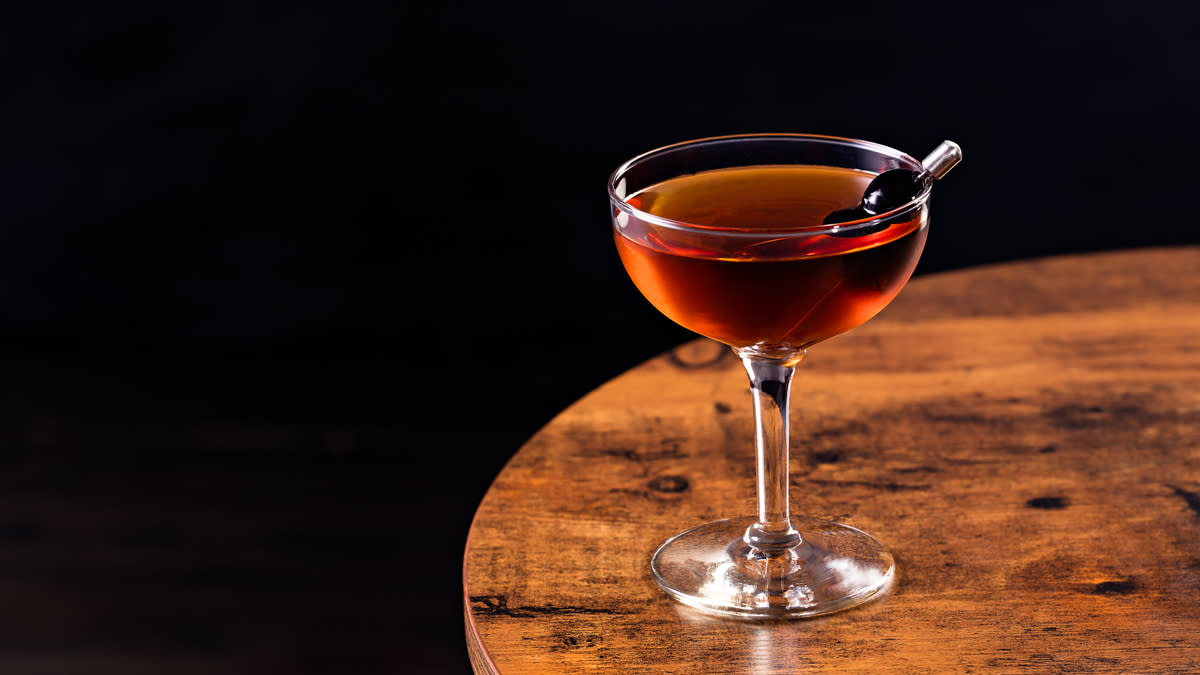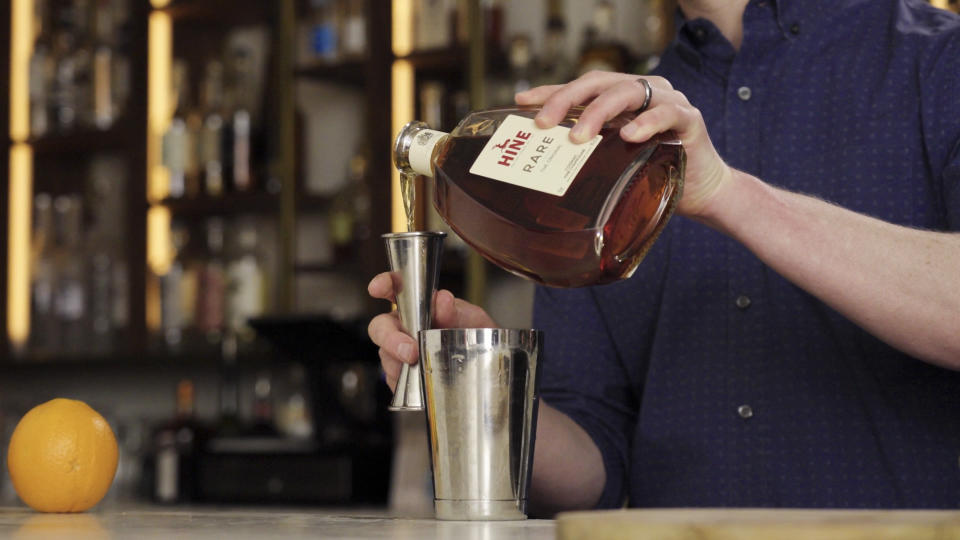How to Make a Corpse Reviver No. 1, the Hangover Cure That’s Much Better as a Nitecap

- Oops!Something went wrong.Please try again later.
The Corpse Reviver No. 1 is the Fredo Corleone of cocktails. It’s Kendall Roy shouting about how he’s the eldest boy and losing anyway. It is, since it was put into print in 1930, universally known as the “Corpse Reviver No. 1,” and yet has been so thoroughly overshadowed by its little sister (the Corpse Reviver No. 2) that most people are barely aware of its existence. Even now, when drink culture has never been bigger or more popular, if I polled 100 cocktail fans, I’d be surprised if three of them had ever even seen one.
This, in and of itself, isn’t that unusual: Bad cocktails get forgotten all the time. What’s peculiar about the Corpse Reviver No. 1 is that it’s not bad at all—well, not if you make it right anyway, more on that later—but more that it’s just unlucky. It’s a drink that was set up to fail.
More from Robb Report
Why the Coolest Bar in Town Might Just Be at Your Tailor's Shop
This $1 Million Cognac Is One of the Most Expensive Ever Released
How to Make a Mexican Firing Squad, the Bright Tequila Cocktail That Brings a Little Bang
In 1930, Harry Craddock, lead bartender at London’s posh Savoy Hotel, published the hugely influential Savoy Cocktail Book, an expansive collection of some 700 original and collected recipes. Among those are the recipes for Corpse Revivers Nos. 1 and 2, “Corpse Reviver” being one of a dozen fun names they had back then for hangover cures (other good ones: “eye-openers,” “phlegm-cutters,” and “anti-fogmatics”). Corpse Reviver No. 2, the famous one, is a tart and juicy affair, electric and invigorating, a terrific hangover cure and indeed among the best a.m. cocktails ever created. The Corpse Reviver No. 1, by contrast, is literally none of those things.
The Corpse Reviver No. 1 is two parts Cognac, one part apple brandy, and one-part sweet vermouth, and Craddock editorializes that it is “to be taken before 11 a.m., or whenever steam and energy are needed.” 11 a.m! Put this together in your head for a second: It’s a Manhattan except stronger, with grape and apple brandies instead of rye, and this, we’re asked to believe, is something to drink before 11a.m. And hey—I’ve been a bartender my whole adult life and am no stranger to the charms of day-drinking, but if someone offered me a brandy Manhattan before lunch, I don’t know about you, but my reaction to this would be something down the lines of: “What are you out of your fucking mind?”
This is the reason no one’s had the Corpse Reviver No. 1. It’s the proverbial fish being asked to climb a tree. No one—no one—wants any of those things before sunset much less before 11 a.m., and the Corpse Reviver No. 1 is so spectacularly ill-suited to morning drinking, I’m still not sure Craddock’s wasn’t making some kind of Jazz-Age joke that doesn’t translate to modernity.
That said: Free the Corpse Reviver No. 1 from its purported purpose and take it as a drink in itself, and it can be phenomenal, with the operative words being “can be.” Craddock’s original specifications failed to make a single palatable version across more than two dozen attempts with different brandies and vermouths but reduce the brandy a little and add a dash of orange bitters, and the Corpse Reviver No. 1 shows itself as a perfectly wonderful cocktail in its own right, robust like a Manhattan but with a subtle core of orchard fruit; powerfully oaked and alluringly spiced. Not strong like a powerlifter, but strong like a gymnast.
Just do yourself a favor—save it for until the sun goes down. For the love of God.
Corpse Reviver No. 1
1.5 oz Cognac, VSOP or older
0.5 oz apple brandy
1 oz Carpano Antica Sweet Vermouth
2 dashes orange bitters
Add ingredients to a mixing glass with ice and stir for 10 to 15 seconds (for small ice) or 20 to 30 seconds (for big ice). Strain up into a cocktail or coupe glass, and garnish with a cherry.
NOTES ON INGREDIENTS

Cognac: We often—not always, but often—feel that the richer, older side of Cognac is better for cocktails, and that’s never been truer than here. When Cognac is younger it has a raw fruitiness, which can be lovely (particularly in sour-style cocktails), but this cocktail doesn’t want any hint of a young brandy funk. Grab a Cognac with VSOP or older.
Apple Brandy: I tried skipping the apple brandy, and it just doesn’t work. It needs the apple brandy for a core of fruitiness, which translates to a kind of texture that’s important for the personality of the drink. I wish I could save you money by saying you don’t need apple brandy, but you do.
As for styles—I preferred American apple brandy to the earthier French Calvados, even though Calvados is called for in the recipe by name. Calvados is still good, but at the end of the day I thought the robust personality of Calvados drowned out some of the charms of the other ingredients. My favorite of the American apple brandies I tried was the Laird’s 86 proof, which is 100 percent apple brandy but less intense than the more common bonded 100 proof.
Sweet Vermouth: I insist on Carpano Antica Sweet Vermouth in the above recipe because of the five vermouths I tried, not only was Carpano Antica the best, it was the best by a significant margin. Yes, Carpano is relatively expensive, but it wasn’t even close. If you’re interested in making Corpse Reviver No. 1s, definitely pick up a bottle.
Orange Bitters: The original recipe doesn’t call for bitters, but the cocktail needs it for depth and complexity. Some talented people use Angostura Bitters, the same as you would a normal Manhattan. This is good, but it makes the cocktail taste like a not-as-good Manhattan. Orange bitters, on the other hand, combines with the fruity core of the apple brandy to make something completely new, and completely delicious. It tasted pretty good with all the orange bitters I tried, so I’d say just use what you have or can get, but if you’re looking to optimize, the chamomile notes in Bitter Queens “Opulent Odessa” Orange Bitters took the day.
Best of Robb Report
Why a Heritage Turkey Is the Best Thanksgiving Bird—and How to Get One
The 10 Best Wines to Pair With Steak, From Cabernet to Malbec
Sign up for Robb Report's Newsletter. For the latest news, follow us on Facebook, Twitter, and Instagram.

